Museums & Institutions
Tate Britain Has Re-Hung Its Collection to Better Represent the U.K.’s Past. Here Are 5 Must-See Works That Reflect the Change
Tate Britain’s Director, Alex Farquharson, walks us through the museum.
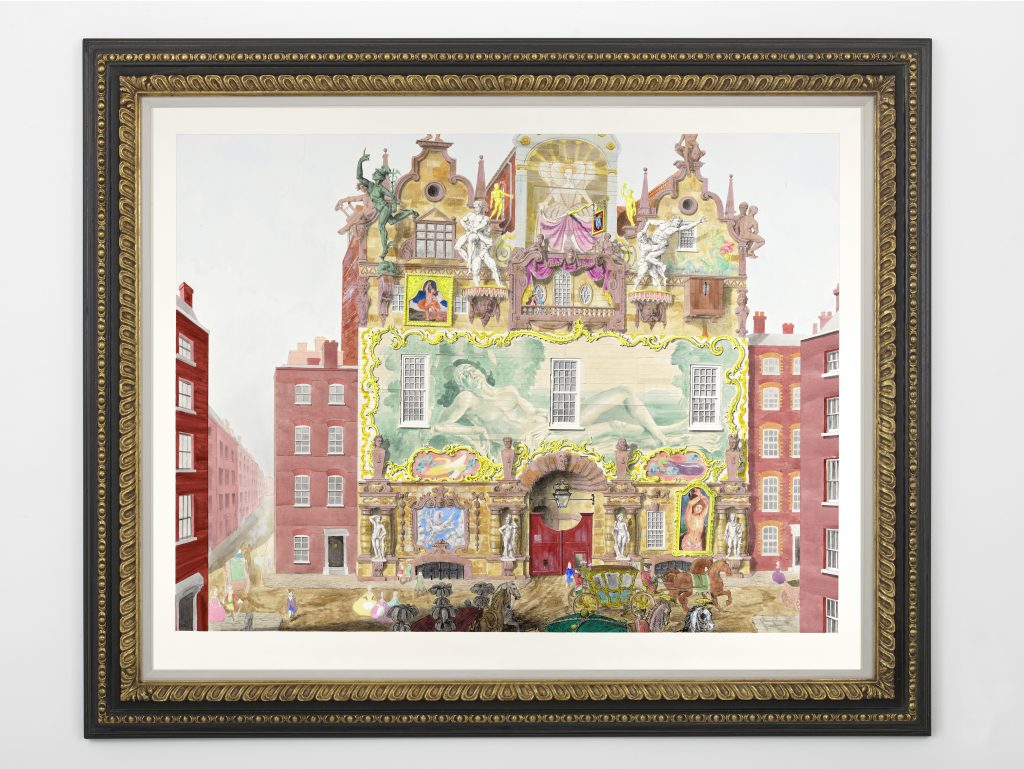
Tate Britain’s Director, Alex Farquharson, walks us through the museum.

Holly Black

It has been ten years since Tate Britain last rehung its permanent collection and, in that time, museums have had something of a reckoning. Broad public and critical opinion have demanded that institutions better reflect the U.K.’s history, by grappling with the darker aspects of the nation’s past, from the legacies of slavery to the erasure of women artists.
Tate’s overhaul has promised to do that, not only by shaking up exactly what is on display (which tops over 800 works), but by adding renewed context and connections between artists, their work, and the wider socio-political context of the day. There is also a much broader understanding of what British art actually means, encompassing a long history of immigration and asylum that dates back to the Tudor era. “This is a chance to not only give space to more marginalized perspectives, but also show that art is not made in a vacuum,” Tate Britain’s director, Alex Farquharson told Artnet News. “It speaks in complex ways about the society we live in.”
This has meant refining the chronological format of some 40 rooms, to offer more thematic interpretations that might include seismic world events such as World War II or the Haitian revolution, as well as the general sentiment or collective psyche of a period, including the existentialism of the mid 20th-century and the new urbanism of the Victoria era.
Naturally, the demand for beloved works such as David Hockney’s A Bigger Splash and John Everett Millais’ Ophelia to take prime position is high. However, through the introduction of new commissions that can recontextualize familiar pieces, as well as the inclusion of overlooked but nevertheless brilliant artists, this new hang feels all the richer. Here, Farquharson talks us through five of these examples, explaining, “We want to look beyond the frame, to see what is absent as well as what’s in the image.”
This wonderfully camp acrylic and ink drawing by Argentinian artist Pablo Bronstein depicts an 18th-century “molly house.” These gay clubs were held in coffee houses and private residences in relative secrecy, and were often subjected to violent police raids at a time when homosexuality was punishable by death. Bronstein decided to reimagine this disturbing narrative, utilizing the architectural language of the period and infusing it with an entirely new sensibility.
“He has chosen, rather anachronistically, to depict molly houses as something out and proud,” Farquharson said. “Rather than a typical, discreet Georgian facade, you have an extraordinarily flamboyant Baroque building that is filled with imagery that is offering something of a ‘greatest hits’ of erotic art, from Saint Sebastian to Eros.” Bronstein’s new commission shows the hidden side of life in Georgian London, one that William Hogarth dare not even show in his satirical and moralistic etchings of city life, which are also on display.
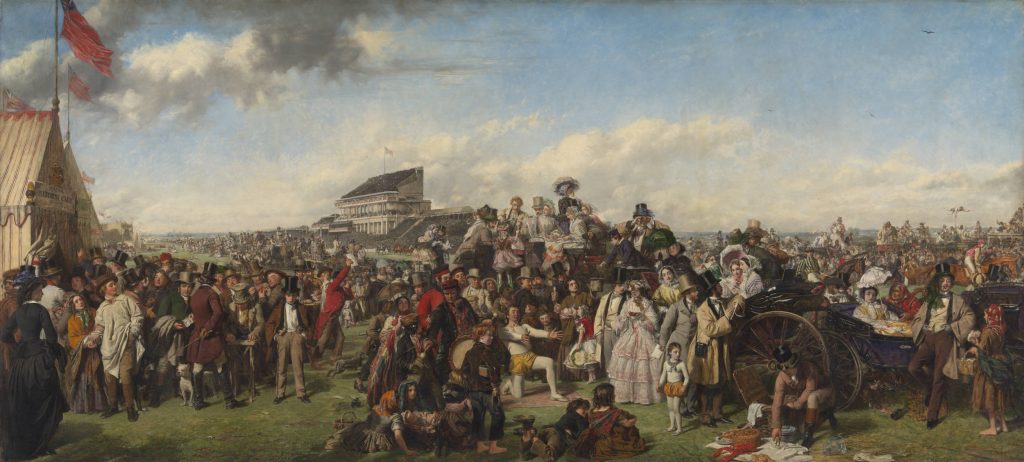
William Powell Frith, The Derby Day (1856–58). Photo by Tate Photography.
This densely populated panorama celebrates the new possibilities of industrialization in Victorian Britain, specifically the advantages of train travel, yet it is also an exercise in social commentary. The scene depicts people from all walks of life who have come together to witness the annual derby at Epsom Downs in Surrey, and it is filled with vignettes designed to entertain, from lavishly dressed ladies in carriages, to circus performers and pickpockets.
“This is a great example of how the Victorians invented a new form of painting, where there is no real distinction between popular culture and high art,” Farquharson said. “Artists are reflecting more of contemporary life, often on a big scale, with an emphasis on storytelling or high drama. They also invented the blockbuster exhibition. When this painting was first exhibited in 1856 at the Royal Academy people queued around the block. A railing had to be erected to hold the public back and a police presence was required.”
Frith’s picture also gives a sense of the birth of the Tate collection. “The building was originally called the National Gallery of British Art, meaning contemporary Victorian art of the time” Farquharson added. “Much of what is on show in this area of the rehang comes from the collection of the gallery’s founder Henry Tate.”
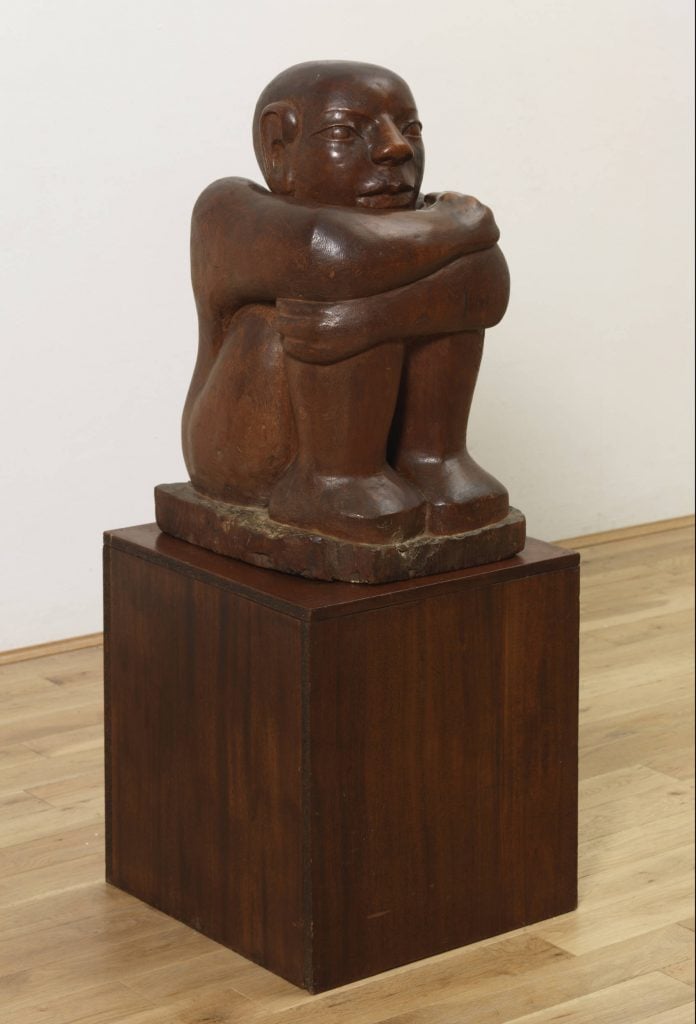
Ronald Moody, The Onlooker (1958–62). ©The estate of Ronald Moody. Photo by Tate Photography.
“In the post-war period Europe and Britain are in ruins, traumatized by war and the horrors of the Holocaust. We enter a world much more without God and existentialism becomes a very popular theory,” Farquharson said. “It was a time of enormous trauma, but also one of renewed freedom, of decolonization and immigration.”
Ronald Moody had already moved to London from Jamaica by the 1920s, but soon abandoned a successful career in dentistry to pursue art in Paris in 1938. He returned to the British capital to escape Nazi occupation, sculpting stunning wood pieces that embody what Farquharson described as “the fragility of humanity, both physically and psychologically.” Carved in teak, The Onlooker presents the figure of the artist as a watchful observer, crouching and wrapping his arms around his body tightly, as if for protection.
The smooth surface is nevertheless scored with the marks of the sculptor’s tools, as well as a natural split in the wood running through the body as if it might fall open. A dark, natural stain in the material also appears just below the figure’s right eye, as if he is crying.
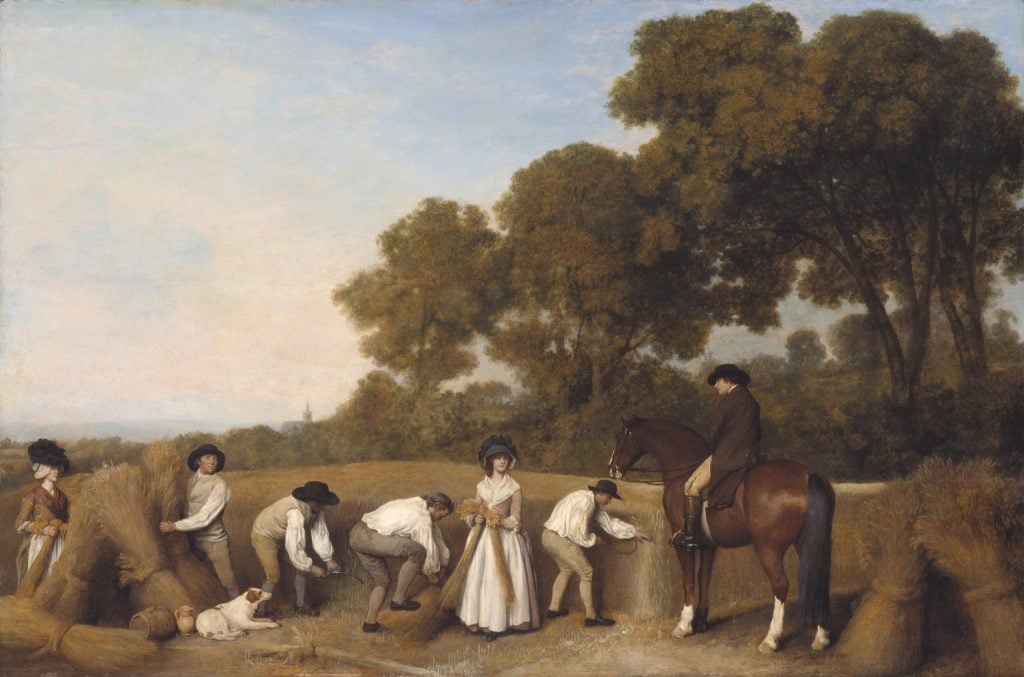
George Stubbs, Reapers (1785). Photo by Tate Photography.

George Stubbs, Haymakers (1785). Photo by Tate Photography.
“During the 18th century, members of parliament were passing acts that allowed local landowners to ‘enclose’ or rather steal common land, which the working class relied upon to feed themselves and make a living,” Farquharson explained. “There was this perpetual idea that land owning was a genteel and gentlemanly pursuit, both at home and abroad, which is why artists such as George Stubbs created idealized notions of farm work and even slavery, as seen in the nearby painting Dancing Scene in the Caribbean, (1764–96) by Agostino Brunias.”
In these two paintings by Stubbs, who was known for his bucolic scenes and animal pictures, the labor seems almost leisurely, where well-dressed men and women joyfully go about their duty while drenched in sunshine. These visions could not be farther from the realities of backbreaking rural labor.
“These are completely misleading pictures of fantasy,” Farquharson added. “They were designed to propagate a positive image of the landowning class, and to make them feel better about themselves. As part of the rehang we wanted to create dialogue around these works, to once again show what has been left unseen. That is why we introduced Olivia Plender’s Set Sail for the Levant: A Board Game About Debt (for Social Satire) (2007), which uses a Monopoly-style format to show just how cruel the realities of life were in this period. For most members of society, the odds are stacked heavily against you.”
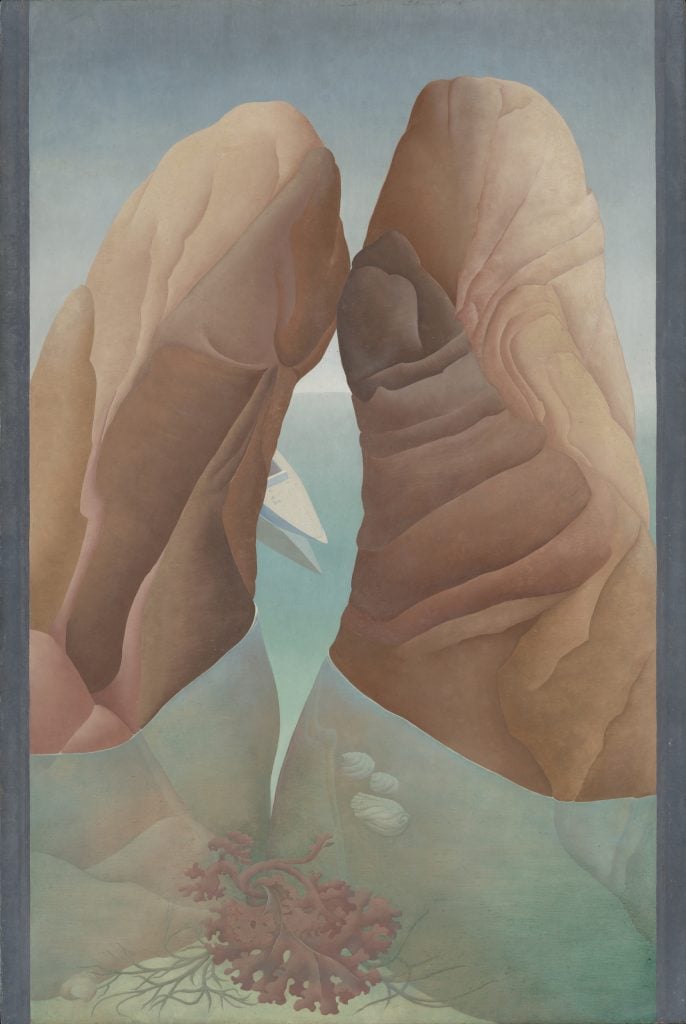
Ithell Colquhoun, Scylla (1938). ©Spire Healthcare, ©Noise Abatement Society, ©Samaritans. Photo by Joe Humphrys, courtesy of the Tate.
According to Farquharson, “the rehang better reflects the contributions of women artists throughout Britain’s history, beginning with the Tudor period right up to the present day. We showcase modern masters, including Barbara Hepworth [and the lesser-known] Ithell Colquhoun.” The artist commanded her own form of surrealism, inspired by the coastal surroundings of her adoptive home of Cornwall. While other artists created implicit images of human sexuality, Colquhoun’s Scylla is almost graphic in its dualistic depiction of “female body as seascape.”
The title is a nod to a supernatural, monstrous creature from Greek mythology, who hid in shallow waters to devour unsuspecting prey, including six of Odysseus’s companions. The two rock formations, which double as legs yet also appear somewhat phallic, frame a patch of seaweed, which stands in for public hair. The only presence of the man-made world takes the form of a diminutive sailing boat apparently on course to dock or perhaps crash on the rocks. Such a scene could allude to the unwelcome presence of masculinity imposed on mother nature. Whatever the interpretation, this painting is a fascinating example of women’s vital contribution to surrealism in Britain and beyond.